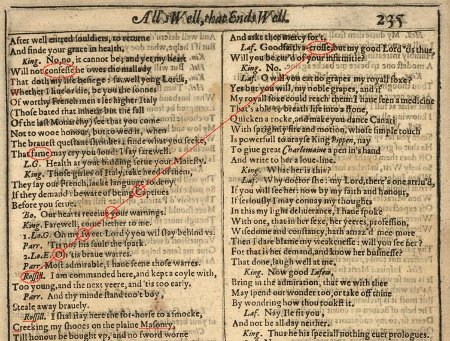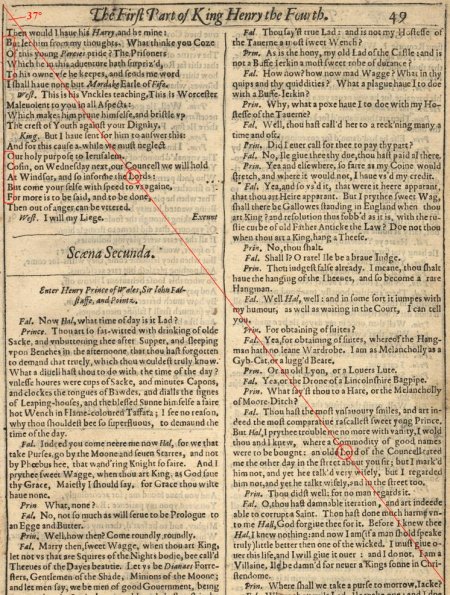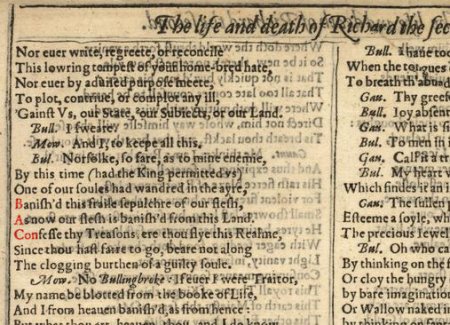Codes in Shakespeare
In the Norwegian book, Organisten (Dan/Swe: Ekspedition/Expedition Shakespeare), Petter Amundsen presents several ciphers in the works of William Shakespeare. A newer English e-book and film have also been produced. I will here try to investigate some of the alleged ciphers.
Contents
Bacon acrostics
Rosy Cross
Star map
Comparing to quartos
Miscellaneous
Oak Island
Conclusion
Appendix - images
Bacon acrostics
To the Reader has a w which should be capitalized and the three first outermost letters spell TWO. On page 2, another TwO appears, next to "F BACon".
This Figure, that thou here seest put,
It was for gentle Shakespeare cut;
Wherein the Grauer had a strife
with Nature, to out-doo the life :
O,could he but haue dravvne his vvit
As vvell in brasse, as he hath hit

Can such acrostics be found anywhere? A search for BACon in the First Folio yields only two hits:
$ tr '\n' = < 00ws110.txt |egrep -io '=B[^=]*=+A[^=]*=+Con[^=]*' |tr = '\n' Begun to tell me what I am, but stopt And left me to a bootelesse Inquisition, Concluding, stay: not yet Banish'd this fraile sepulchre of our flesh, As now our flesh is banish'd from this Land. Confesse thy Treasons, ere thou flye this Realme,
Other simple acrostics are also rare: TwO (1), BACON (0), FBACO (0), OCABF (1), BACO (1), OCABF (0), ConAB (2), FBAC (1), 'O w T' (1).
I do not believe that all acrostics are intended ciphers. However, I think that some of my findings are interesting. I think it's peculiar that a BACon is on page 2 of Comedies when I found BACon reversed on page 2 of Tragedies, especially knowing that only one other BACon (without the preceding "F ") and one other reversed BACon (indented) exist. I also think it's funny that the only FBAC and OwT I found are on the same page.
The three parts of the First Folio are about 300 pages long, so the probability of no "page number collisions" (assuming random distribution of the "BACon"s) is about 1 * 897/900 * 894/900 * 891/900 ~= 98.01%.
Rosy Cross

This page is mentioned in epilogue 4 of Organisten (not in the first edition of the book), but not the circled parts. Petter Amundsen found "R-O-s-y C" between Rossi and crosse after I told him about my discovery of fame and confesse. It's at a 53 degree angle of course! It's discussed further in the e-book.
The e-book says the following about the other Rosie Cross triange: "a hyphened adjective with a peculiar feature: “un-Sunn’d”, the strangeness being the capital S."

I checked and found that it's not unique, but admittedly unusual:
$ grep '[uv]n-[A-Z]' 00ws110.txt God saue King Henry, vn-King'd Richard sayes, And therefore Ile vn-Crowne him, er't be long. As Chaste, as vn-Sunn'd Snow. Oh, all the Diuels! Appeare vn-Kinglike
I also verified another e-book quote: "A brief inspection of the complete Cymbeline uncovers no similar groups of words with capital letters C.R.C."
$ egrep -o 'C\w*\W+R\w*\W+C\w*' 00ws110.txt Cedar, Royall Cymbeline
Actually, the word group in Cymbeline is the only C.R.C. combination in all of the plays.
Star map
I'm convinced that Boötes and Wain (and Swan) are hidden in the Shake-speare productions, but do they form the geometric symbols that Petter Amundsen claim? To be a perfect match, the stars should fit the following diagram:
The distance between Regulus (Leo) and Deneb (Cygnus) is 119.47700 degrees, the distance between Arcturus (Boötes) and Capella is 103.03220 degrees. All stars are the brightest of their constellation. We get a proportion of 119.47700/103.03220=1.15961, which is 99.4% of the expected 1.16667 (7/6). The length and width match, but is the figure straight? CapellaDeneb/ArcturusDeneb = 78.18639/80.85666 = 96.7%. And finally, do the 6 and 7 units long lines cross at the right place? RegulusDeneb and ArcturusCapella intersect at about +54°51'11", 11h45'14", and IntersectionToRegulus = 46.9390° and IntersectionToDeneb = 72.5801°, which gives us IntersectionToRegulus/IntersectionToDeneb = 0.6467 = 86.2% of 3/4.

The star map is partly based on acrostics like the one above. This one is on page 37 of The Two Gentlemen of Verona, the first page to be mislabeled as The Merry Wives of Windsor. I think it's curious that I find another star on the next, and final page of the play, which is also mislabeled.

The two stars Tania Australis and Tania Borealis mark the left hind foot of Ursa Major.
The page number 169 should be special to the Rosicrucians because 16=4^2, 9=3^2, and 169=13^2, which is why I wonder about two possible stars in 3 Henry VI:

Tejat and Almeisan (a.k.a. Alhena) are the brightest stars in Gemini after Castor and Pollux (son of Cygnus, the swan). Tejat is the left "back foot" or heel of Castor, and Almeisan is the left foot of Pollux.

None of these stars fit the existing star map.
Comparing to quartos
I thought it a good idea to compare the First Folio to the previous quarto and had a look at 1 Henry IV.
My first observation is that the two are very similar, only a few words are changed, and mostly the same ones. Many & have been replaced by and, and many expressions such as by the Lord and Zounds have been removed. The FBACO acrostic spans two pages in Q5, which I think discredits it a bit. The line between the Lords is also uncertain, as I see no obvious signs of manipulation of their positions. The removal of the other Lords could be a good sign, but since they are all "by the Lord", it doesn't look as good. Much the same goes for page 53, but Bottes/BoOtes and Boots/Bootes seem very plausible.
Miscellaneous
Geometric patterns and shapes are difficult to evaluate because of their subjective nature. One that I think can be measured more objectively is the five Lords in a row on page 131 of Histories. The page has 12 Lords in total, 66 lines and 82 characters per line in average. For 3 randomly placed Lords to be aligned between two others, we have approximately (64/66)*(63/66)*(62/66)*1/82^3*nCr(10,3)=0.000189..., i.e. 0.02% probability of coincidence. Unfortunately, that number is neither large enough nor small enough to settle any real doubt on its own.
Finally, an acrostic I have found, which could be nothing, is TAROT on the final page of All's Well That Ends Well.

Oak Island
One of the claims I am hesitant to accept immediately is that there are references to Oak Island. If one were to point to Oak Island, however, I'll admit that the Swan is the star constellation closest to the mark:
Conclusion
I have only focused on a few of the discoveries here, notably those I've been unsure about or contibuted to. Personally, I am convinced that Rosy Cross, Boötes, and Bacon ciphers exist in the publications, but I'm not sure what they signify.
You may also be interested in my Summary of most convincing Bacon ciphers in Shakespeare.
Appendix - images
Boötes in Antony and Cleopatra

Page 346 of The Tragedy of Antony and Cleopatra contains the only TwO I have found beyond page 2 of The Tempest, and the only FBAC in the Folio. The OwT is part of "BOwTHS" (=Boötes).
BACon on page 2 of Tragedies


I have found only two Con-A-B, and it's fitting that one of them is on page 2, mirroring the B-A-Con on page 2 of Comedies. Also a possible BOWTIs anagram. The other instance is indented and prefixed with Fra.
37/53 degrees of the 3-4-5 triangle in 1 Henry IV

This page and its acrostic ciphers are mentioned in Organisten, but the line was not. It passes through the page's only two "Lord"s, intersects the upper left corner, and has a 37 degree angle. I'm still not completely sure whether the finds on this page is accidental or not.
BACO on page 281
The most promising BACO I've found is on page 281 (prime), The Winters Tale. I'm guessing the others are coincidences (Comedies p. 21 and Tragedies p. 127).


The final BACon is on Histories p. 27 (Richard II):

Created on Fri, 25 Dec 2009 21:29
blog comments powered by Disqus




